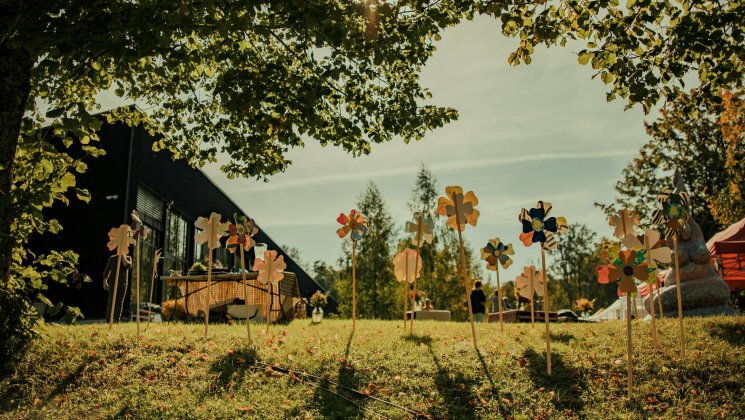-
Humanitaarteaduste ja kunstide valdkondHumanitaarteaduste ja kunstide valdkonna dekanaatJakobi 2, r 116-121 51005 Tartu linn, Tartu linn, Tartumaa EST0Ajaloo ja arheoloogia instituutJakobi 2 51005 Tartu linn, Tartu linn, Tartumaa EST0Eesti ja üldkeeleteaduse instituutJakobi 2, IV korrus 51005 Tartu linn, Tartu linn, Tartumaa ESTFilosoofia ja semiootika instituutJakobi 2, III korrus, ruumid 302-337 51005 Tartu linn, Tartu linn, Tartumaa EST0Kultuuriteaduste instituutÜlikooli 16 51003 Tartu linn, Tartu linn, Tartumaa EST0Maailma keelte ja kultuuride instituutLossi 3 51003 Tartu linn, Tartu linn, Tartumaa EST0UsuteaduskondÜlikooli 18 50090 Tartu linn, Tartu linn, Tartumaa EST0Viljandi kultuuriakadeemiaPosti 1 71004 Viljandi linn, Viljandimaa EST0Humanitaarteaduste ja kunstide valdkonna emeriitprofessorid0Humanitaarteaduste ja kunstide valdkonna emeriitdotsendid0Sotsiaalteaduste valdkondSotsiaalteaduste valdkonna dekanaatLossi 36 51003 Tartu linn, Tartu linn, Tartumaa EST0Haridusteaduste instituutJakobi 5 51005 Tartu linn, Tartu linn, Tartumaa EST0Johan Skytte poliitikauuringute instituutLossi 36, ruum 301 51003 Tartu linn, Tartu linn, Tartumaa EST0MajandusteaduskondNarva mnt 18 51009 Tartu linn, Tartu linn, Tartumaa EST0Psühholoogia instituutNäituse 2 50409 Tartu linn, Tartu linn, Tartumaa EST0ÕigusteaduskondNäituse 20 - 324 50409 Tartu linn, Tartu linn, Tartumaa EST0Ühiskonnateaduste instituutLossi 36 51003 Tartu linn, Tartu linn, Tartumaa EST0Narva kolledžRaekoja plats 2 20307 Narva linn, Ida-Virumaa EST0Pärnu kolledžRingi 35 80012 Pärnu linn, Pärnu linn, Pärnumaa EST0Sotsiaalteaduste valdkonna emeriitprofessorid0Sotsiaalteaduste valdkonna emeriitdotsendid0Meditsiiniteaduste valdkondMeditsiiniteaduste valdkonna dekanaatRavila 19 50411 Tartu linn, Tartu linn, Tartumaa ESTBio- ja siirdemeditsiini instituutBiomeedikum, Ravila 19 50411 Tartu linn, Tartu linn, Tartumaa ESTFarmaatsia instituutNooruse 1 50411 Tartu linn, Tartu linn, Tartumaa ESTHambaarstiteaduse instituutL. Puusepa 1a 50406 Tartu linn, Tartu linn, Tartumaa ESTKliinilise meditsiini instituutL. Puusepa 8 50406 Tartu linn, Tartu linn, Tartumaa ESTPeremeditsiini ja rahvatervishoiu instituutRavila 19 50411 Tartu linn, Tartu linn, Tartumaa ESTSporditeaduste ja füsioteraapia instituutUjula 4 51008 Tartu linn, Tartu linn, Tartumaa ESTMeditsiiniteaduste valdkonna emeriitprofessorid0Meditsiiniteaduste valdkonna emeriitdotsendid0Loodus- ja täppisteaduste valdkondLoodus- ja täppisteaduste valdkonna dekanaatVanemuise 46 - 208 51003 Tartu linn, Tartu linn, Tartumaa ESTArvutiteaduse instituutNarva mnt 18 51009 Tartu linn, Tartu linn, Tartumaa ESTGenoomika instituutRiia 23b/2 51010 Tartu linn, Tartu linn, Tartumaa ESTEesti mereinstituutMäealuse 14 12618 Tallinn, Harjumaa EST0Füüsika instituutKeemia instituutRavila 14a 50411 Tartu linn, Tartu linn, Tartumaa ESTMatemaatika ja statistika instituutNarva mnt 18 51009 Tartu linn, Tartu linn, Tartumaa EST0Molekulaar- ja rakubioloogia instituutRiia 23, 23b - 134 51010 Tartu linn, Tartu linn, Tartumaa ESTTartu observatooriumObservatooriumi 1 61602 Tõravere alevik, Nõo vald, Tartumaa EST0TehnoloogiainstituutNooruse 1 50411 Tartu linn, Tartu linn, Tartumaa ESTÖkoloogia ja maateaduste instituutJ. Liivi tn 2 50409 Tartu linn, Tartu linn, Tartumaa ESTLoodus- ja täppisteaduste valdkonna emeriitprofessorid0Loodus- ja täppisteaduste valdkonna emeriitdotsendid0Akadeemilise sekretäri tegevusvaldkondPersonaliosakondÜlikooli 18, ruumid 302 ja 304 50090 Tartu linn, Tartu linn, Tartumaa EST0Finantsjuhi tegevusvaldkondRahandusosakondJakobi 4 51005 Tartu linn, Tartu linn, Tartumaa EST0Kantsleri tegevusvaldkondInfotehnoloogia osakondUppsala 10 51003 Tartu linn, Tartu linn, Tartumaa EST0KantseleiÜlikooli 17 (III korrus) 51005 Tartu linn, Tartu linn, Tartumaa EST0Kinnisvaraosakond0Turundus- ja kommunikatsiooniosakondÜlikooli 18, ruumid 102, 104, 209, 210 50090 Tartu linn, Tartu linn, Tartumaa EST0Õppeprorektori tegevusvaldkondÕppeosakondTeaduskoolUppsala 10 51003 Tartu linn, Tartu linn, Tartumaa ESTÜliõpilaskonna bürooÜlikooli 18b 51005 Tartu linn, Tartu linn, Tartumaa EST0Õppimis- ja õpetamiskeskusLossi 36-401 51003 Tartu linn, Tartu linn, Tartumaa ESTTeadusprorektori tegevusvaldkondRaamatukoguW. Struve 1 50091 Tartu linn, Tartu linn, Tartumaa ESTGrandikeskusRaekoja plats 9, III korrus 51004 Tartu linn, Tartu linn, Tartumaa ESTArendusprorektori tegevusvaldkondEttevõtlus- ja innovatsioonikeskusNarva mnt 18 51009 Tartu linn, Tartu linn, Tartumaa EST0Loodusmuuseum ja botaanikaaedVanemuise 46 51003 Tartu linn, Tartu linn, Tartumaa EST0Rahvusvahelise koostöö ja protokolli osakond0MuuseumLossi 25 51003 Tartu linn, Tartu linn, Tartumaa EST0Rektori tegevusvaldkondRektoraadi bürooÜlikooli 18 50090 Tartu linn, Tartu linn, Tartumaa ESTSiseauditi büroo
Muhu Slippers with Bobbinwork Embroidery
Teachers: Mari Pukk and Alliki Oidekivi
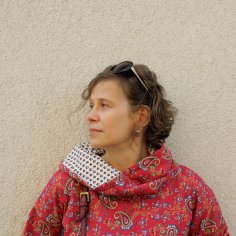
Mari Pukk (b 1968) graduated from the Olustvere School of Service and Rural Economics in 2010, specialising in native textile crafts and has later worked at the same school as a teacher of textile crafts. She has also worked as an editor for the magazine Käsitöö, edited handicraft textbooks and conducted handicraft training courses. In 2019, she graduated from the UT Viljandi Culture Academy with a degree in Estonian Native Textiles. Based on her research on printed fabrics, she has established a small textile design company HYLDA, which aims to reproduce old patterns and create new ones for use in traditional clothing.

Alliki Oidekivi (b 1967) graduated from the Tallinn Technical School of Light Industry in 1987 as a sewing industry technologist and in 2014 from the UT Viljandi Culture Academy with a degree in Estonian Native Textiles, specializing in the making of folk costumes and traditional leatherwork. Her works have been exhibited in shows and exhibitions (OmaMood, 2013 and 2014; Ajast Aega Ajatu, 2014; Ajatus, 2018), and she has participated in contests (Eesti-oma-märss, 2007; Eesti-maa-villane, 2013). Alliki's instructions have been published in the book „Loo, koo, rõõmusta“ („Create, Knit, Rejoice“) and in the magazine „Käsitöö“ („Handicraft“). Since 2015, she has conducted handicraft training courses: sewing, knitting, crochet, tablet weaving and the making of Muhu slippers. The focus of these courses is to learn and use traditional handicraft methods. In 2020, Alliki graduated from a two-year-long course in the Folk Costume Courses in Saaremaa.
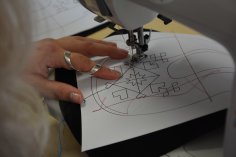
Textile footwear was worn in the 19th century, mainly on the islands of Western Estonia and in Eastern and Southeastern Estonia. 'Muhu pätid' or Muhu slippers, the richly embroidered textile slippers which are famous even today, evolved from simple everyday footwear.
During the period before World War I, when leather shoes were expensive, people began to embellish everyday slippers, initially with cross-stitch embroidery and monograms, leather or broadcloth bindings and rick rack trims, to give them a more festive look. In the 1910s and 1920s, they began to be decorated with elaborate satin stitch floral embroidery. The slippers were also decorated with bobbinwork embroidery using a sewing machine.
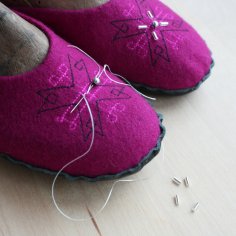
During this two-day workshop, a pair of slippers decorated with bobbinwork embroidery will be made using traditional slipper-making techniques from Muhu Island. On the first day, we will make the slipper pattern with a suitable embroidery design, decorate the uppers with bobbinwork embroidery, finish with beads and sew the uppers to the lining. On the second day, we will stretch the uppers on the shoe lasts, sew the soles and finish the slippers.
The participation fee includes all necessary materials for making one pair of slippers. The shoe sizes will be confirmed with the participants before the course. The workshop is somewhat physically demanding. This workshop is suitable for advanced participants who have prior experience in sewing.
|
Image
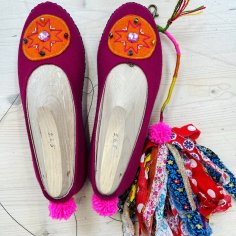
|
Image
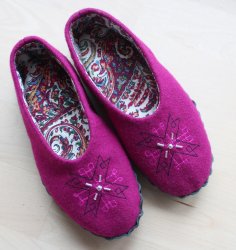
|
Image
|
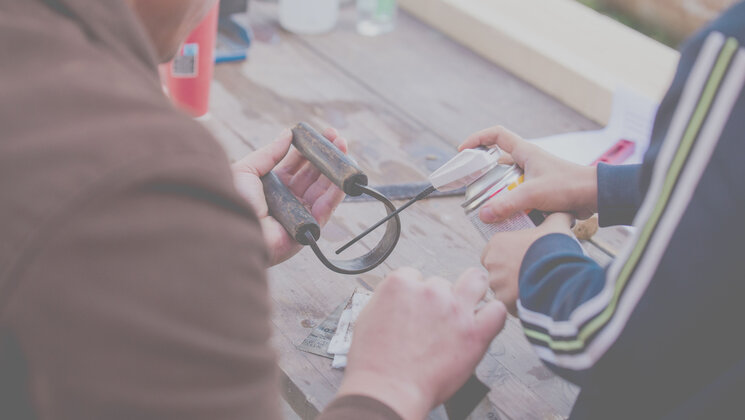
Pärandilinn Viljandi otsib 2024. aasta pärandusfestivalile osalejaid
Kultuuriakadeemias valminud sämplipank avab pärimuspillide helimaailma laiemale publikule
